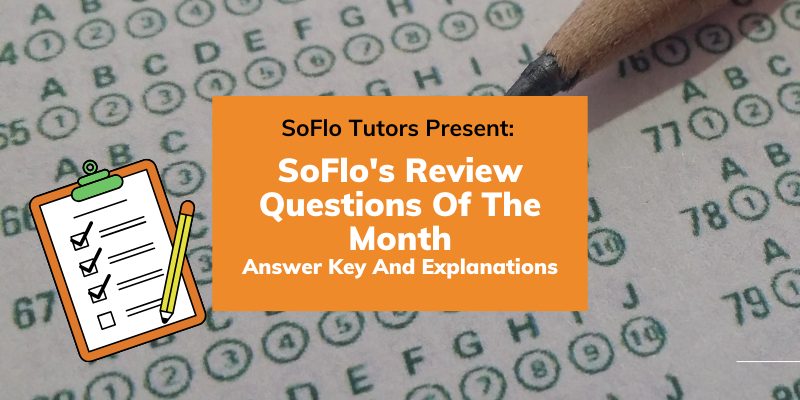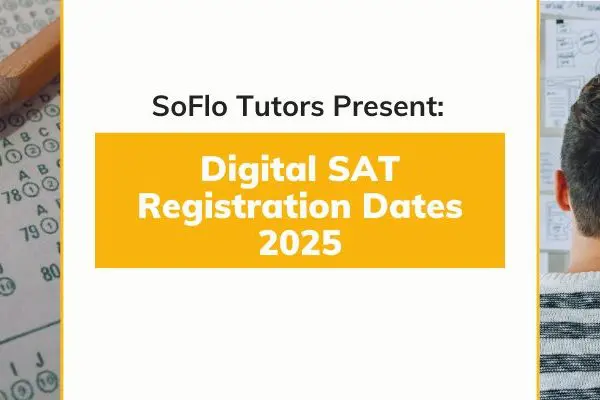
Each month, SoFlo sends out a newsletter with a SAT/ACT Review Question. This is the answer key with the correct response and short explanation.
Sign up for SoFlo’s newsletter to receive these monthly practice questions here.
Still confused about the answer? Book a FREE session with a SoFlo Tutor to get an in-depth explanation and walk through here.
December
Correct Answer: C
The easiest way to solve this problem with a calculator is to use the graphing function. When you graph it, you will see the curve below and can clearly tell that it only touches quadrants I, II, and IV. Therefore, the answer is quadrant IV because there is no point of the curve that touches that quadrant (and therefore, there will be no coordinates that satisfy the inequality).
To solve this without a calculator, you can draw a rough sketch of the parabola using the equation given and key points you can derive. First, expand the expression to y = x^2 – 6x + 8. Thus, you can tell that the graph will be an upwards parabola. Because y is greater than or equal to the right hand side, y will be the area above the parabola.
Then, you can use the equation to find some key points: the vertex, x-intercepts, and y-intercept.
To find the vertex, you can actually use the original form the equation. In the following form (h, k) will be the vertex.
Y = a(x-h)^2 + k
Therefore, the vertex will be (3, 1). If you want to use the expanded version, you can use the vertex formula: h = – b/2a where y = ax^2 +bx +c. You will get the same answer.
To find the y-intercept, you can set the original equation’s x’s to 0. When you do this, you will find that y = 8. Therefore, the y-intercept is (0, 8).
To find the x-intercepts, you can set the original equation’s y to 0. Using the expanded version of the equation will be helpful here. You can factor the equation 0 = x^2 – 6x + 8 to be 0 = (x-2) * (x-4). Therefore, the solutions are x = 2, 4. The x-intercepts will be (2, 0), and (4, 0).
Using these four points, you can see where the parabola will roughly cross each axis and you will get a graph similar to the one in Desmos. From this, you can easily see that the parabola and its inside crosses through all quadrants except for quadrant III. Therefore, there is no point in quadrant III that will satisfy the inequality.
November

Answer choices:
A) NO CHANGE
B) Helvoetsluys
C) Helvoetsluys:
D) Helvoetsluys;
Correct Answer: D
Explanation
If you read the sentence in full, it is definitely a mouthful. This should be your first sign that this is probably a run-on sentence as is and needs some breaking up.
To be more technical, though, you should recognize that the parts before and after the underlined comma are two independent clauses. An independent clause is a full sentence – it has its own subject, verb, and expresses a complete thought. One of the most obvious indicators that they are two independent clauses is that they express closely related, but ultimately different ideas. Leslie is talking about the effect of the red dot on Turner’s painting, but is saying two separate things on what it accomplishes. The first is that it “dramatically alters the painting,” and the second is that it “deals a blow to his adversary” (see the preceding sentence that sets up these two points). Another indicator is that each phrase contains its own subject and verb.
- “Fellow painter C.R. Leslie observed that the prominent spot of red against the otherwise muted seascape ultimately perfected Helvoetsluys.” (Subject: Leslie, Verb: Observed)
- “At the same time, Turner’s sparing use of color seemed to mock Constable’s adjacent painting, which appeared clutters and overworked by comparison.” (Subject: Turner’s sparing use of color, Verb: Mock)
Therefore, the answer is D because a semicolon is the only grammatically correct way to join two independent clauses together of all the choices provided.
Grammar Refresher 101
Make sure you understand why the other answers are incorrect! To ace the ACT, you should completely understand the where and when is right to use a comma, colon, and semi-colon.
To review:
A comma has a wide variety of uses (ie. to separate items in a list, include nonessential items), but in this context, it would be used to join two independent clauses. A comma can only join two independent clauses together, however, if it is followed by a coordinating conjunction (for, and, nor, but, or, yet, so – remember FANBOYS!). In answer choice A, the comma is not followed by one of the FANBOYS so it cannot be used.
A colon is used to introduce a list, an explanation, or expansion. One important aspect of a colon is that it is continuing on an already-existing idea. As mentioned, the two clauses are related ideas, but they are still distinct and do not directly follow from one another.
A semicolon joins two independent clauses. If you’re ever in doubt if a semicolon can be used, try replacing it with a period (or a comma + FANBOYS). It should function the same and the two sentences should be complete (with a subject and verb each). You should use semicolons instead of periods if the two sentences you’re talking about are transitionally or closely related things.
October

Answer choices:
A) y = -kx
B) y = – x/k
C) y = (1-x)/k
D) y = x – (1/k)
Correct Answer: B
Explanation
To determine the equation of q, we need two things: the slope and y-intercept.
Q and R are perpendicular, which means that their slopes are the opposite reciprocal of each other. For example, if the slope of one line is 2, then the slope of the perpendicular line would be – 1/2.
First, we can find the slope of R by using the two coordinates provided: the origin (0,0), and (1, k). Using the slope formula, the slope of R is k. Therefore, the slope of Q is the negative reciprocal, which is -1/k.
The only thing left to figure out is the y-intercept, but we know from the question that both lines intersect at the origin. When x = 0, y is also 0 for Q, so the y-interception will be 0.
Putting both the slope and y-intercept together, we get the equation of Q, which is y = (-1/k)x + 0, which can be simplified to just y = – x/k.










